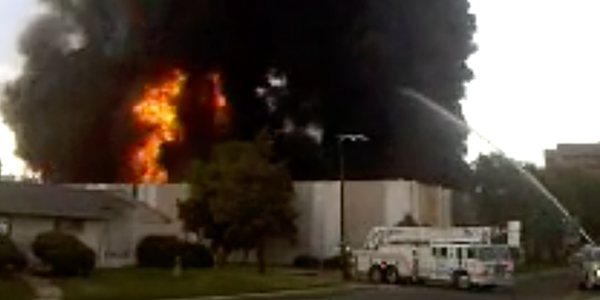
By Rich Heidorn Jr.
Consolidated Edison’s Anthony Natale has summarized what he’s learned about substation fires over two decades in several bullet points. But the biggest lesson, he says, is one of humility.
“These are low-frequency, high-hazard events. We don’t do them often enough to get good at them,” he said Wednesday during a NERC lessons-learned webinar.
That’s all the more reason, he said, for setting up a framework for responding to fires. It starts with identifying appropriate response techniques; memorializing the techniques into a policy; and then using the policy as a platform for training — training that includes the fire department.
“You cannot meet the fire department for the first time at the command post,” he said.

Firefighters arrived before utility workers at this 2010 transformer fire in Denver, making matters worse by using water that may have spread burning transformer oil.
Natale joined representatives from Georgia Power, Florida Power & Light and the Midwest Reliability Organization for the webinar, which was hosted by Richard Hackman, NERC’s senior event analysis adviser for reliability risk management.
Hackman noted that although some utility substations are enclosed, most are outdoors, and many are in rural areas with volunteer fire departments with limited resources.
“We’re trying to help get that addressed by … getting these lessons learned out and getting the discussion going,” Hackman said. The webinar recording and slides are available for utilities to present to their fire departments.
Although the presentation included specific lessons from individual fires, Hackman said the “generic [lessons] are the most valuable.”
“The primary one is before any substation fire occurs, we need to have a working relationship between the electric utility and the fire department. [The utility needs] to describe the hazards in the substation to the fire department. The fire department needs to be able to explain their needs to the electric utilities.”

Because not all fire departments have foam, Georgia Power has equipped small trailers with 5-gallon containers of foam concentrate and an oil spill response kit that it can deploy to fires. | Georgia Power
“Basically, everything in a substation is a hazard,” said Michael Bocovich, principal systems protection engineer for MRO, citing energized equipment, PCBs, toxins from burning plastics and metals, and porcelain that is extremely sharp when broken. Ground rods can be trip hazards, and “anything that’s in the air is a hazard for falling: bus section switches, insulators, conductors,” he continued.
“Some other hazards you may not think of also can include angered animals. I know racoons have been the source of many substation faults. They’re tough, mean animals. They can survive a fault, and they’re not very happy after that happens. I’ve also heard reports of bears in substations.”
Because of the hazards, utilities must train firefighters not to enter a substation without a utility escort, who can ensure equipment has been de-energized.
“You have to establish a policy up front because they’re going to employ their everyday tactics,” Natale said. “They’re going to get in and they’re going to search.”

Con Edison posted these signs outside every point of access to its substations to remind firefighters not to enter without a utility worker escort. | Con Edison
To prevent that, Con Ed has posted signs outside its substations with the logos of both the utility and the New York Fire Department. “That sign is essentially a stop sign, and this is what keeps them from forcing entry,” Natale explained.
Bocovich described a 2010 transformer fire at a Denver substation that was captured on video. The substation was next door to the firehouse, so firefighters arrived immediately and began spraying water on the blaze before utility personnel arrived.
That was not a good idea. NERC says water should never be used on a transformer fire. It will sink below the transformer oil that is heated above the boiling temperature of water, causing a “boil over.”
“Water may have allowed burning oil to spread to other equipment,” Bocovich said. “There was another transformer on site that was destroyed by this fire also.”
Foam is the preferred firefighting technique for transformer fires and their oil. Because not all fire departments have foam, Georgia Power’s Scott Cox said, his utility has equipped small trailers with containers of foam concentrate and an oil spill response kit that it can deploy to fires.
“No water,” Natale emphasized. “You don’t want to sustain a boil-over because you’ll end up burning down the entire substation. Water is fine to use if you’re going to protect exposures. But you’re not knocking down a transformer fire with it.”


